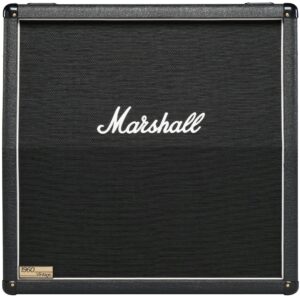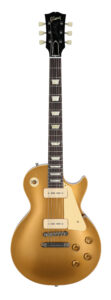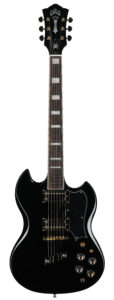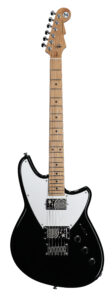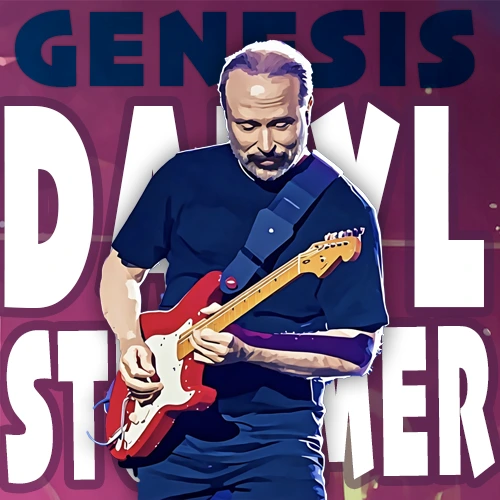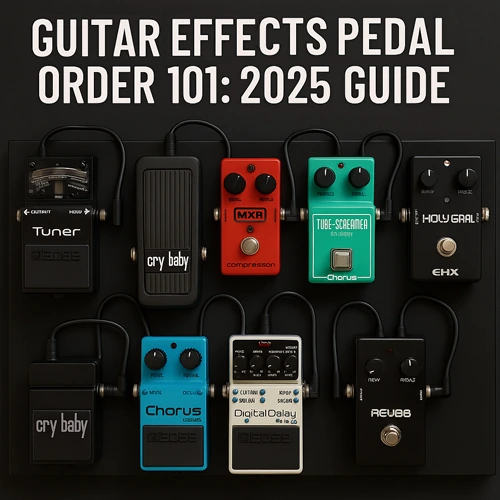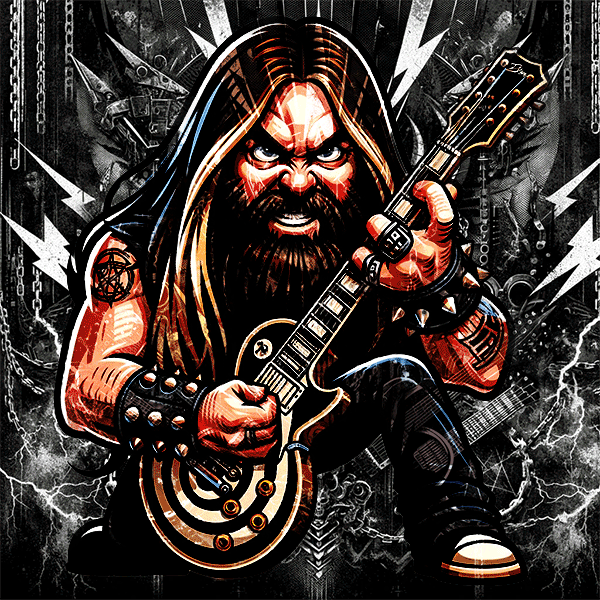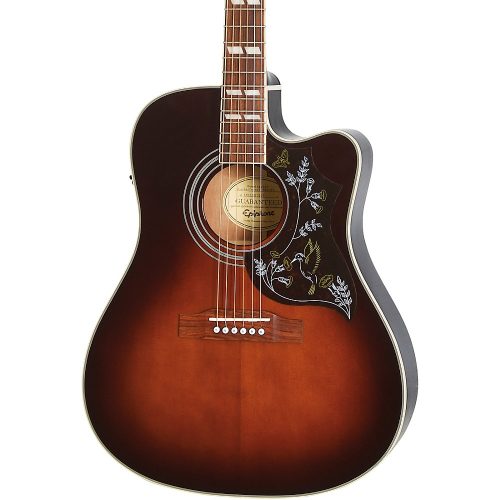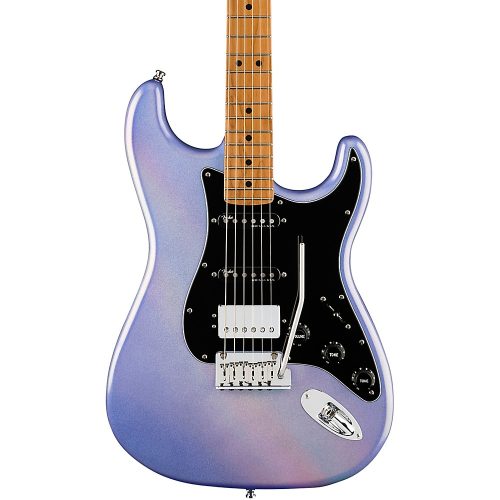
Table of Contents
Welcome to the first installment of “The Guitars that Powered the Genre,” where we take a deep dive into the instruments that shaped music history. Today, we’re exploring the guitars that defined grunge—a movement that turned the guitar world upside down with pawn shop finds, broken equipment, and an attitude that said technical perfection could go to hell.
In the late 1980s, something was brewing in Seattle’s damp basements and cramped clubs. Musicians were creating a sound that would demolish the glossy excess of hair metal and change guitar culture forever. The grunge revolution wasn’t just about the music—it was about accessibility, authenticity, and proving you could make history with a $200 guitar from a pawn shop.
Seattle’s Perfect Storm Created a New Guitar Philosophy
The grunge movement emerged from a unique collision of geography, economics, and cultural rebellion. Seattle in the mid-1980s was, as Sub Pop co-founder Bruce Pavitt described it, “a remote and provincial city” that was “very working class” and “very poor.” This isolation forced musicians to develop their own sound, while economic necessity shaped their equipment choices.
The aesthetic wasn’t manufactured—it was survival. Work clothes, thrift store finds, and pawn shop guitars weren’t fashion statements but economic realities. When Kurt Cobain bought his first electric guitar, it wasn’t even a brand name. “I think it was a Sears,” he later recalled. This necessity-driven approach would fundamentally change how guitarists thought about their instruments.
The movement gained momentum with the 1986 “Deep Six” compilation, featuring Soundgarden, Green River, and the Melvins. Producer Jack Endino, dubbed the “Godfather of Grunge,” established the production template that would define the genre. His philosophy was simple: capture what the band actually sounded like, not some idealized version. Recording Nirvana’s “Bleach” for just $606.17 proved that revolutionary music didn’t need expensive studios.
Kurt Cobain Turned Cheap Guitars into Grunge Icons
No discussion of grunge guitars can begin without Kurt Cobain’s arsenal of modified Fender offsets. His guitar choices weren’t about prestige—they were about finding instruments that felt right and could be destroyed without breaking the bank.
The Competition Mustang that launched a thousand bands
Cobain’s most famous guitar was his 1969 Lake Placid Blue Fender Mustang, serial number F 279651. This Competition-striped beauty appeared in the “Smells Like Teen Spirit” video and became the visual symbol of grunge guitar. Purchased around 1990, just before recording “Nevermind,” this Mustang featured Cobain’s preferred modifications: a Stewart MacDonald Gotoh Tune-O-Matic bridge for better intonation and blocked tremolo system.
The guitar’s significance went beyond its appearance. With its 24-inch scale length and lightweight body, the Mustang offered something different from the superstrats dominating the 1980s. As Cobain explained:
“Out of all the guitars in the whole world, the Fender Mustang is my favourite. They’re cheap and totally inefficient, and they sound like crap and are very small.”
That “inefficiency” became a feature, not a bug. When this guitar sold at auction in 2023 for $4.5 million, it proved how profoundly Cobain had transformed perceptions of what made a guitar valuable.
The Jaguar that defined “Nevermind”
Cobain’s 1965 sunburst Fender Jaguar (serial #95747) served as his main guitar during the “Nevermind” era. Already heavily modified when he bought it through the LA Recycler, it featured DiMarzio PAF and Super Distortion pickups, a red-swirl pickguard, and simplified switching. This wasn’t a pristine vintage instrument—it was a working tool modified for maximum impact.
The Jaguar’s unique pickup configuration and 24-inch scale created the cutting tone heard throughout “Nevermind.” Its ability to handle heavy distortion while maintaining clarity made it perfect for Cobain’s dynamic playing style, shifting from gentle arpeggios to explosive power chords.
The Jag-Stang experiment
In 1993, Cobain designed his own guitar by literally cutting photos of a Jaguar and Mustang in half and taping them together. Fender’s Custom Shop built two prototypes of this “Jag-Stang,” though Cobain used them sparingly. The design reflected his philosophy: take existing ideas, modify them to suit your needs, and don’t worry about convention.
Essential effects and amplification
Cobain’s tone relied on a surprisingly simple signal chain. The Boss DS-1 Distortion became synonymous with grunge, with Cobain running it with all knobs maxed except the tone control. The Electro-Harmonix Small Clone chorus created the watery texture on “Come As You Are” and the pre-chorus of “Smells Like Teen Spirit.”
For amplification, Cobain used a Mesa Boogie Studio Preamp into various power amps, eventually settling on Crest Audio 4801s—what his tech called “the amp that wouldn’t die.” This setup, combined with walls of Marshall 4×12 cabinets, created the massive yet articulate sound that defined Nirvana’s live performances.
Pearl Jam Brought Gibson Power to Grunge
While Nirvana embraced Fender’s offset guitars, Pearl Jam took a different path. The dual-guitar attack of Stone Gossard and Mike McCready combined Gibson’s thick, sustaining tones with Fender’s clarity and sparkle.
Stone Gossard’s Les Paul arsenal
Gossard’s main guitars throughout Pearl Jam’s career have been Gibson Les Pauls, particularly a 1972 Goldtop and various Les Paul Customs. His sunburst Les Paul, owned since his Mother Love Bone days, provided the thick rhythm tones that anchored Pearl Jam’s sound. These guitars, equipped with Duncan Alnico II pickups, delivered the warmth and sustain needed for his melodic rhythm playing.
Gossard’s evolution included adopting Fender Stratocasters for their versatility in live settings. His approach to effects evolved from simple setups in the early days (Ibanez TS-9 Tube Screamer, Boss Chorus) to elaborate pedalboards featuring boutique effects like the Klon Centaur overdrive.
Mike McCready’s vintage Stratocaster magic
McCready’s main instrument remains his 1960 Fender Stratocaster, a sunburst beauty he purchased in 1992 after “Ten” brought success. Originally thought to be a 1959, this battle-scarred Strat has been his constant companion, delivering the Stevie Ray Vaughan-influenced leads heard on classics like “Alive” and “Black.”
His Gibson collection includes a stunning Les Paul ‘Burst and several other vintage models. The contrast between his Strats and Les Pauls gave Pearl Jam’s guitar sound remarkable depth—bright, cutting leads from the Fenders and thick, creamy tones from the Gibsons.
Soundgarden’s Kim Thayil Revolutionized Alternative Tunings
Kim Thayil’s approach to guitar was perhaps the most experimental in grunge. His main instrument since 1978 has been a Guild S-100 Polara, purchased for $250 in Illinois. This guitar’s unique construction—with extra space between bridge and tailpiece—allowed Thayil to play behind the bridge, creating otherworldly sounds that became his signature.
The Guild that defined a sound
Thayil’s black 1990s Guild S-100 reissue became his primary touring guitar, chosen for its microphonic pickups that enhanced feedback and harmonics. Unlike many players who’d consider such pickups a flaw, Thayil embraced their “hot, loud, rambunctious tone.” The guitar’s feel was crucial—as he noted, if a guitar didn’t feel right, the performance would suffer regardless of how it sounded.
In 2023, Guild honored Thayil with signature models, including a limited USA Artist Edition S-100 Polara with hand-wound Jason Lollar pickups, acknowledging his role in making these overlooked guitars legendary.
Alternative tunings that changed rock
Thayil pioneered the use of alternative tunings in mainstream rock, with Soundgarden employing numerous custom tunings:
- Drop D for “Outshined,” “Spoonman,” and “Jesus Christ Pose”
- CGCGGE for “Pretty Noose”
- EEBBBE for “My Wave”
These tunings weren’t gimmicks—they opened new harmonic possibilities and created Soundgarden’s distinctively heavy yet melodic sound. Thayil’s willingness to experiment inspired countless guitarists to explore beyond standard tuning.
Smashing Pumpkins Brought Precision to the Chaos
Billy Corgan’s approach differed from his Seattle contemporaries. While embracing grunge’s heavy tones, he brought a perfectionist’s attention to guitar layering and tone crafting.
The Stratocaster collection
Corgan’s journey began with a 1974 Fender Stratocaster purchased from drummer Jimmy Chamberlin for $275. This yellow Strat, decorated with psychedelic artwork, defined the sound of “Gish.” After it was stolen in 1992, Corgan’s “Bat Strat”—a ’57 reissue with Lace Sensor pickups—became his main instrument through the “Siamese Dream” and “Mellon Collie” era.
The Lace Sensors were crucial to Corgan’s sound, reducing electromagnetic interference while maintaining single-coil character. This allowed him to use massive amounts of gain without excessive noise, essential for his “wall of guitars” production approach.
Modern evolution
Corgan’s recent adoption of Reverend guitars, particularly the BC1 Terz model, shows his continued evolution. With its 21.5-inch scale and unique tuning, this instrument provides what Corgan calls “the Mellon Collie sound with little need for pedals.”
The Underground Heroes Shaped Grunge’s Diversity
Alice in Chains: Jerry Cantrell’s G&L revolution
Jerry Cantrell’s main guitars through Alice in Chains‘ classic era were G&L Rampages, particularly his famous “Blue Dress” model. This single-humbucker guitar, decorated with a pin-up sticker, defined Alice in Chains’ heavy yet melodic sound. The Seymour Duncan JB pickup and maple construction provided the clarity needed for Cantrell’s complex harmonies and drop-tuned riffs.
Mudhoney: Fuzz pioneers
Steve Turner’s Guild Starfire semi-hollows and Mark Arm’s Gretsch Duo Jets, combined with Big Muff fuzz pedals, created Mudhoney’s raw, garage-rock influenced sound. Turner’s philosophy—using “high-rated garbage”—embodied grunge’s anti-establishment approach to gear.
Hole: Eric Erlandson’s aluminum experiments
Erlandson’s use of rare Veleno aluminum guitars, introduced to him by Kurt Cobain, provided the sustain and high-end clarity heard on “Live Through This.” These all-metal instruments, combined with his blue 1960s Mustang, created Hole’s aggressive yet melodic guitar sound.
The Technical Recipe for Grunge Tone
The grunge sound emerged from specific technical choices that rejected 1980s production values:
Distortion democracy
The Boss DS-1 became grunge’s secret weapon. At around $50, it democratized heavy guitar tones. Settings were typically extreme—level and distortion maxed, tone adjusted to taste. The Electro-Harmonix Big Muff provided alternatives, each adding unique character to the grunge palette.
Amplifier simplicity
Marshall JCM800s, Mesa Boogies, and Fender Twin Reverbs dominated. These amps provided different flavors—Marshall’s aggressive midrange, Mesa’s tight low-end, Fender’s clean headroom for pedal distortion. The key was simplicity: plug in, turn up, and let the guitar and pedals do the work.
Production philosophy
Jack Endino’s recording approach defined grunge’s sound. Recording to tape at 15 IPS for extra low-end, using minimal processing, and capturing live energy over technical perfection created the raw, immediate sound that connected with millions.
The Guitars of Grunge Chart
| Artist | Guitar | Year | Mods | Songs | Sound |
|---|---|---|---|---|---|
| Kurt Cobain (Nirvana) |
Fender Mustang | 1969 Lake Placid Blue | Gotoh bridge, blocked trem | “Teen Spirit” | Raw DS-1 tone |
| Kurt Cobain (Nirvana) |
Fender Jaguar | 1965 Sunburst | DiMarzio pickups | “Nevermind” | Clean to heavy |
| Stone Gossard (Pearl Jam) |
Gibson Les Paul | 1972 Goldtop | Duncan Alnico II | “Alive” | Warm rhythm |
| Mike McCready (Pearl Jam) |
Fender Strat | 1960 Sunburst | Original vintage | “Black” | Blues-rock leads |
| Kim Thayil (Soundgarden) |
Guild S-100 | 1990s Black | Microphonic PUs | “Black Hole Sun” | Alt tunings |
| Billy Corgan (Smashing Pumpkins) |
Fender Strat | ’57 “Bat Strat” | Lace Sensors | “Today” | Wall of guitars |
| Jerry Cantrell (Alice in Chains) |
G&L Rampage | “Blue Dress” | Duncan JB | “Man in Box” | Heavy harmonies |
| Steve Turner (Mudhoney) |
Guild Starfire | 1960s | Big Muff fuzz | “Touch Me” | Garage fuzz |
| Eric Erlandson (Hole) |
Veleno Aluminum | 1970s | Metal body | “Violet” | High sustain |
Why Grunge Captured a Generation
Grunge exploded into popularity because it resonated deeply with a generation of disaffected and isolated young people. For the first time, they felt understood. The artists were young, authentic, and shared similar struggles, giving voice to feelings many couldn’t express themselves.
The movement thrived partly due to its accessibility—cheap gear from pawn shops and simple, powerful riffs meant anyone could join in. Previously, guitar idols like Eddie Van Halen, Eric Clapton, and David Gilmour had seemed distant and unreachable, masters whose skills felt unattainable to average teenagers.
Then Kurt Cobain arrived. As a guitarist, he was technically average and relied on budget equipment anyone could afford. But as a songwriter, he was extraordinary—crafting powerful riffs and melodies that captured a generation’s collective angst and frustration. His music became a rallying cry, proving that authenticity could surpass much more polished performers.
Cobain’s life ended tragically, yet his legacy endures, forever defining grunge and inspiring countless musicians who learned you don’t have to be a rich guitar wizard to make music that moves millions.
Why Grunge Guitars Mattered: Changing the World, Three Chords at a Time
The grunge movement’s impact on guitar culture extends far beyond the 1990s. The movement also revived interest in offset Fenders, with vintage Mustang prices jumping from $700 to over $2,500. Manufacturers now produce numerous grunge-inspired instruments, acknowledging the lasting influence of players who chose authenticity over artifice.
Perhaps most importantly, grunge reminded us that guitars are tools for expression, not trophies for display. Whether it was Cobain’s beat-up Mustang, Thayil’s feedback-friendly Guild, or Cantrell’s modified G&L, these instruments proved that passion and creativity matter more than price tags or technical specifications.
As we continue “The Guitars that Powered the Genre” series, remember that grunge’s legacy isn’t just in the music—it’s in the philosophy that anyone with a guitar and something to say can change the world. You don’t need the most expensive gear or the fastest fingers. You need conviction, creativity, and the courage to plug in and play.
Stay tuned for our next installment, where we’ll explore how guitars shaped another revolutionary genre. Until then, grab that guitar gathering dust in your closet. It might just be your ticket to creating something extraordinary.
👉 Check out more deals and gear reviews on the Get My Guitar Blog.
👉 Join our guitarist community to share your finds and discuss all things guitar!
👉 Check out the very latest Guitar News.
Disclosure: This post contains affiliate links. If you purchase through these links, we may earn a commission at no extra cost to you.
Recent Posts
Imagine this: it's 1980, and after a Genesis rehearsal, Phil Collins offers a Milwaukee guitarist a ride back into [...]
Ever wonder why your pedalboard sounds like mud even though you've got quality gear? The answer usually comes down [...]
Do you ever find yourself air-drumming to your favorite track and thinking, "Man, I need to be playing this [...]
Blog Categories
Tags

Table of Contents
Welcome to the first installment of “The Guitars that Powered the Genre,” where we take a deep dive into the instruments that shaped music history. Today, we’re exploring the guitars that defined grunge—a movement that turned the guitar world upside down with pawn shop finds, broken equipment, and an attitude that said technical perfection could go to hell.
In the late 1980s, something was brewing in Seattle’s damp basements and cramped clubs. Musicians were creating a sound that would demolish the glossy excess of hair metal and change guitar culture forever. The grunge revolution wasn’t just about the music—it was about accessibility, authenticity, and proving you could make history with a $200 guitar from a pawn shop.
Seattle’s Perfect Storm Created a New Guitar Philosophy
The grunge movement emerged from a unique collision of geography, economics, and cultural rebellion. Seattle in the mid-1980s was, as Sub Pop co-founder Bruce Pavitt described it, “a remote and provincial city” that was “very working class” and “very poor.” This isolation forced musicians to develop their own sound, while economic necessity shaped their equipment choices.
The aesthetic wasn’t manufactured—it was survival. Work clothes, thrift store finds, and pawn shop guitars weren’t fashion statements but economic realities. When Kurt Cobain bought his first electric guitar, it wasn’t even a brand name. “I think it was a Sears,” he later recalled. This necessity-driven approach would fundamentally change how guitarists thought about their instruments.
The movement gained momentum with the 1986 “Deep Six” compilation, featuring Soundgarden, Green River, and the Melvins. Producer Jack Endino, dubbed the “Godfather of Grunge,” established the production template that would define the genre. His philosophy was simple: capture what the band actually sounded like, not some idealized version. Recording Nirvana’s “Bleach” for just $606.17 proved that revolutionary music didn’t need expensive studios.
Kurt Cobain Turned Cheap Guitars into Grunge Icons
No discussion of grunge guitars can begin without Kurt Cobain’s arsenal of modified Fender offsets. His guitar choices weren’t about prestige—they were about finding instruments that felt right and could be destroyed without breaking the bank.
The Competition Mustang that launched a thousand bands
Cobain’s most famous guitar was his 1969 Lake Placid Blue Fender Mustang, serial number F 279651. This Competition-striped beauty appeared in the “Smells Like Teen Spirit” video and became the visual symbol of grunge guitar. Purchased around 1990, just before recording “Nevermind,” this Mustang featured Cobain’s preferred modifications: a Stewart MacDonald Gotoh Tune-O-Matic bridge for better intonation and blocked tremolo system.
The guitar’s significance went beyond its appearance. With its 24-inch scale length and lightweight body, the Mustang offered something different from the superstrats dominating the 1980s. As Cobain explained:
“Out of all the guitars in the whole world, the Fender Mustang is my favourite. They’re cheap and totally inefficient, and they sound like crap and are very small.”
That “inefficiency” became a feature, not a bug. When this guitar sold at auction in 2023 for $4.5 million, it proved how profoundly Cobain had transformed perceptions of what made a guitar valuable.
The Jaguar that defined “Nevermind”
Cobain’s 1965 sunburst Fender Jaguar (serial #95747) served as his main guitar during the “Nevermind” era. Already heavily modified when he bought it through the LA Recycler, it featured DiMarzio PAF and Super Distortion pickups, a red-swirl pickguard, and simplified switching. This wasn’t a pristine vintage instrument—it was a working tool modified for maximum impact.
The Jaguar’s unique pickup configuration and 24-inch scale created the cutting tone heard throughout “Nevermind.” Its ability to handle heavy distortion while maintaining clarity made it perfect for Cobain’s dynamic playing style, shifting from gentle arpeggios to explosive power chords.
The Jag-Stang experiment
In 1993, Cobain designed his own guitar by literally cutting photos of a Jaguar and Mustang in half and taping them together. Fender’s Custom Shop built two prototypes of this “Jag-Stang,” though Cobain used them sparingly. The design reflected his philosophy: take existing ideas, modify them to suit your needs, and don’t worry about convention.
Essential effects and amplification
Cobain’s tone relied on a surprisingly simple signal chain. The Boss DS-1 Distortion became synonymous with grunge, with Cobain running it with all knobs maxed except the tone control. The Electro-Harmonix Small Clone chorus created the watery texture on “Come As You Are” and the pre-chorus of “Smells Like Teen Spirit.”
For amplification, Cobain used a Mesa Boogie Studio Preamp into various power amps, eventually settling on Crest Audio 4801s—what his tech called “the amp that wouldn’t die.” This setup, combined with walls of Marshall 4×12 cabinets, created the massive yet articulate sound that defined Nirvana’s live performances.
Pearl Jam Brought Gibson Power to Grunge
While Nirvana embraced Fender’s offset guitars, Pearl Jam took a different path. The dual-guitar attack of Stone Gossard and Mike McCready combined Gibson’s thick, sustaining tones with Fender’s clarity and sparkle.
Stone Gossard’s Les Paul arsenal
Gossard’s main guitars throughout Pearl Jam’s career have been Gibson Les Pauls, particularly a 1972 Goldtop and various Les Paul Customs. His sunburst Les Paul, owned since his Mother Love Bone days, provided the thick rhythm tones that anchored Pearl Jam’s sound. These guitars, equipped with Duncan Alnico II pickups, delivered the warmth and sustain needed for his melodic rhythm playing.
Gossard’s evolution included adopting Fender Stratocasters for their versatility in live settings. His approach to effects evolved from simple setups in the early days (Ibanez TS-9 Tube Screamer, Boss Chorus) to elaborate pedalboards featuring boutique effects like the Klon Centaur overdrive.
Mike McCready’s vintage Stratocaster magic
McCready’s main instrument remains his 1960 Fender Stratocaster, a sunburst beauty he purchased in 1992 after “Ten” brought success. Originally thought to be a 1959, this battle-scarred Strat has been his constant companion, delivering the Stevie Ray Vaughan-influenced leads heard on classics like “Alive” and “Black.”
His Gibson collection includes a stunning Les Paul ‘Burst and several other vintage models. The contrast between his Strats and Les Pauls gave Pearl Jam’s guitar sound remarkable depth—bright, cutting leads from the Fenders and thick, creamy tones from the Gibsons.
Soundgarden’s Kim Thayil Revolutionized Alternative Tunings
Kim Thayil’s approach to guitar was perhaps the most experimental in grunge. His main instrument since 1978 has been a Guild S-100 Polara, purchased for $250 in Illinois. This guitar’s unique construction—with extra space between bridge and tailpiece—allowed Thayil to play behind the bridge, creating otherworldly sounds that became his signature.
The Guild that defined a sound
Thayil’s black 1990s Guild S-100 reissue became his primary touring guitar, chosen for its microphonic pickups that enhanced feedback and harmonics. Unlike many players who’d consider such pickups a flaw, Thayil embraced their “hot, loud, rambunctious tone.” The guitar’s feel was crucial—as he noted, if a guitar didn’t feel right, the performance would suffer regardless of how it sounded.
In 2023, Guild honored Thayil with signature models, including a limited USA Artist Edition S-100 Polara with hand-wound Jason Lollar pickups, acknowledging his role in making these overlooked guitars legendary.
Alternative tunings that changed rock
Thayil pioneered the use of alternative tunings in mainstream rock, with Soundgarden employing numerous custom tunings:
- Drop D for “Outshined,” “Spoonman,” and “Jesus Christ Pose”
- CGCGGE for “Pretty Noose”
- EEBBBE for “My Wave”
These tunings weren’t gimmicks—they opened new harmonic possibilities and created Soundgarden’s distinctively heavy yet melodic sound. Thayil’s willingness to experiment inspired countless guitarists to explore beyond standard tuning.
Smashing Pumpkins Brought Precision to the Chaos
Billy Corgan’s approach differed from his Seattle contemporaries. While embracing grunge’s heavy tones, he brought a perfectionist’s attention to guitar layering and tone crafting.
The Stratocaster collection
Corgan’s journey began with a 1974 Fender Stratocaster purchased from drummer Jimmy Chamberlin for $275. This yellow Strat, decorated with psychedelic artwork, defined the sound of “Gish.” After it was stolen in 1992, Corgan’s “Bat Strat”—a ’57 reissue with Lace Sensor pickups—became his main instrument through the “Siamese Dream” and “Mellon Collie” era.
The Lace Sensors were crucial to Corgan’s sound, reducing electromagnetic interference while maintaining single-coil character. This allowed him to use massive amounts of gain without excessive noise, essential for his “wall of guitars” production approach.
Modern evolution
Corgan’s recent adoption of Reverend guitars, particularly the BC1 Terz model, shows his continued evolution. With its 21.5-inch scale and unique tuning, this instrument provides what Corgan calls “the Mellon Collie sound with little need for pedals.”
The Underground Heroes Shaped Grunge’s Diversity
Alice in Chains: Jerry Cantrell’s G&L revolution
Jerry Cantrell’s main guitars through Alice in Chains‘ classic era were G&L Rampages, particularly his famous “Blue Dress” model. This single-humbucker guitar, decorated with a pin-up sticker, defined Alice in Chains’ heavy yet melodic sound. The Seymour Duncan JB pickup and maple construction provided the clarity needed for Cantrell’s complex harmonies and drop-tuned riffs.
Mudhoney: Fuzz pioneers
Steve Turner’s Guild Starfire semi-hollows and Mark Arm’s Gretsch Duo Jets, combined with Big Muff fuzz pedals, created Mudhoney’s raw, garage-rock influenced sound. Turner’s philosophy—using “high-rated garbage”—embodied grunge’s anti-establishment approach to gear.
Hole: Eric Erlandson’s aluminum experiments
Erlandson’s use of rare Veleno aluminum guitars, introduced to him by Kurt Cobain, provided the sustain and high-end clarity heard on “Live Through This.” These all-metal instruments, combined with his blue 1960s Mustang, created Hole’s aggressive yet melodic guitar sound.
The Technical Recipe for Grunge Tone
The grunge sound emerged from specific technical choices that rejected 1980s production values:
Distortion democracy
The Boss DS-1 became grunge’s secret weapon. At around $50, it democratized heavy guitar tones. Settings were typically extreme—level and distortion maxed, tone adjusted to taste. The Electro-Harmonix Big Muff provided alternatives, each adding unique character to the grunge palette.
Amplifier simplicity
Marshall JCM800s, Mesa Boogies, and Fender Twin Reverbs dominated. These amps provided different flavors—Marshall’s aggressive midrange, Mesa’s tight low-end, Fender’s clean headroom for pedal distortion. The key was simplicity: plug in, turn up, and let the guitar and pedals do the work.
Production philosophy
Jack Endino’s recording approach defined grunge’s sound. Recording to tape at 15 IPS for extra low-end, using minimal processing, and capturing live energy over technical perfection created the raw, immediate sound that connected with millions.
The Guitars of Grunge Chart
| Artist | Guitar | Year | Mods | Songs | Sound |
|---|---|---|---|---|---|
| Kurt Cobain (Nirvana) |
Fender Mustang | 1969 Lake Placid Blue | Gotoh bridge, blocked trem | “Teen Spirit” | Raw DS-1 tone |
| Kurt Cobain (Nirvana) |
Fender Jaguar | 1965 Sunburst | DiMarzio pickups | “Nevermind” | Clean to heavy |
| Stone Gossard (Pearl Jam) |
Gibson Les Paul | 1972 Goldtop | Duncan Alnico II | “Alive” | Warm rhythm |
| Mike McCready (Pearl Jam) |
Fender Strat | 1960 Sunburst | Original vintage | “Black” | Blues-rock leads |
| Kim Thayil (Soundgarden) |
Guild S-100 | 1990s Black | Microphonic PUs | “Black Hole Sun” | Alt tunings |
| Billy Corgan (Smashing Pumpkins) |
Fender Strat | ’57 “Bat Strat” | Lace Sensors | “Today” | Wall of guitars |
| Jerry Cantrell (Alice in Chains) |
G&L Rampage | “Blue Dress” | Duncan JB | “Man in Box” | Heavy harmonies |
| Steve Turner (Mudhoney) |
Guild Starfire | 1960s | Big Muff fuzz | “Touch Me” | Garage fuzz |
| Eric Erlandson (Hole) |
Veleno Aluminum | 1970s | Metal body | “Violet” | High sustain |
Why Grunge Captured a Generation
Grunge exploded into popularity because it resonated deeply with a generation of disaffected and isolated young people. For the first time, they felt understood. The artists were young, authentic, and shared similar struggles, giving voice to feelings many couldn’t express themselves.
The movement thrived partly due to its accessibility—cheap gear from pawn shops and simple, powerful riffs meant anyone could join in. Previously, guitar idols like Eddie Van Halen, Eric Clapton, and David Gilmour had seemed distant and unreachable, masters whose skills felt unattainable to average teenagers.
Then Kurt Cobain arrived. As a guitarist, he was technically average and relied on budget equipment anyone could afford. But as a songwriter, he was extraordinary—crafting powerful riffs and melodies that captured a generation’s collective angst and frustration. His music became a rallying cry, proving that authenticity could surpass much more polished performers.
Cobain’s life ended tragically, yet his legacy endures, forever defining grunge and inspiring countless musicians who learned you don’t have to be a rich guitar wizard to make music that moves millions.
Why Grunge Guitars Mattered: Changing the World, Three Chords at a Time
The grunge movement’s impact on guitar culture extends far beyond the 1990s. The movement also revived interest in offset Fenders, with vintage Mustang prices jumping from $700 to over $2,500. Manufacturers now produce numerous grunge-inspired instruments, acknowledging the lasting influence of players who chose authenticity over artifice.
Perhaps most importantly, grunge reminded us that guitars are tools for expression, not trophies for display. Whether it was Cobain’s beat-up Mustang, Thayil’s feedback-friendly Guild, or Cantrell’s modified G&L, these instruments proved that passion and creativity matter more than price tags or technical specifications.
As we continue “The Guitars that Powered the Genre” series, remember that grunge’s legacy isn’t just in the music—it’s in the philosophy that anyone with a guitar and something to say can change the world. You don’t need the most expensive gear or the fastest fingers. You need conviction, creativity, and the courage to plug in and play.
Stay tuned for our next installment, where we’ll explore how guitars shaped another revolutionary genre. Until then, grab that guitar gathering dust in your closet. It might just be your ticket to creating something extraordinary.
👉 Check out more deals and gear reviews on the Get My Guitar Blog.
👉 Join our guitarist community to share your finds and discuss all things guitar!
👉 Check out the very latest Guitar News.
Disclosure: This post contains affiliate links. If you purchase through these links, we may earn a commission at no extra cost to you.
Recent Posts
Imagine this: it's 1980, and after a Genesis rehearsal, Phil Collins offers a Milwaukee guitarist a ride back into [...]
Ever wonder why your pedalboard sounds like mud even though you've got quality gear? The answer usually comes down [...]
Do you ever find yourself air-drumming to your favorite track and thinking, "Man, I need to be playing this [...]
Blog Categories
Tags
Leave a Comment
Other Posts
If you’ve ever dreamed of owning a Fender guitar but winced at the price tag, 2025 might finally be your year. Fender has just launched [...]
Zakk Wylde, known for his tenure with Ozzy Osbourne and as the frontman of Black Label Society, is a titan in the world of heavy [...]
Guitar enthusiasts and tone purists, brace yourselves! The MXR Gran Torino Boost Overdrive pedal has landed, bringing with it the promise of organic, tube-like tones [...]





